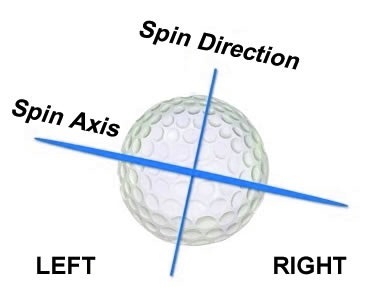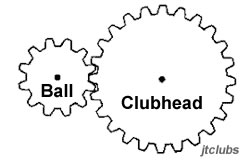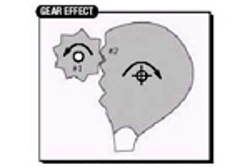First, let’s briefly go over some of the main terms for those that don’t understand what we are talking about.
Rate of Closure is the amount the club face is closing thru the ‘impact interval.’ The impact interval is the time the clubface makes initial contact with the ball, then compresses the ball and then the ball ‘leaves’ the clubface. The more the clubface closes, the ‘higher’ the rate of closure.
Here is the ‘spin axis’ of a golf ball.

You will hear some Trackman fans eschew the word ‘side spin’ because they feel the term indicates that a golf ball can spin two different ways (backspin and side spin). The golf ball has an axis that it spins on. So the Trackman people tend to prefer the ‘tilting of the spin axis.’ Other launch monitor companies will use ‘side spin’ understanding that the ball has an axis and doesn’t spin in two different directions. But, they are essentially figuring out where the axis is tilted and how much the ball is spinning in the direction the axis is tilted creating ‘side spin.’ It’s more or less semantics although I tend to prefer Trackman’s spin axis terminology.
The idea initially before Golf Evolution asked Tuxen the question was that the higher the rate of the closure, the more it would tilt the spin axis in a hook shot direction. And the slower the rate of closure, it would produce more of a slice spin tilt of the ball’s axis.
The idea is that using the D-Plane, where the ball curves based on the path’s relation to the face. So if the golfer had a high rate of closure, the clubface would start closing with relation to the path.
But, with gear effect the Golf Evolution guys felt that the opposite would be true and the ball’s spin axis would actually tilt towards a slice.
First, think of the ball and club face as 2 gears (hence the name, gear effect)

Here is another example illustrating the point:

So…for every action, there is an equal but opposite reaction.
What does that mean here?
So…for every action, there is an equal but opposite reaction.
What does that mean here?
As the clubface is rotating in a counter-clockwise direction (high rate of closure), the ball is going to rotate in a clockwise direction.
Where I have my skepticism is in the assumption that a slow rate of closure will ‘produce more hooks.’ Mainly because with a slower rate of closure, the clubface is still closing. For it to produce more hooks based on what I have shown above, the clubface would have to be moving in a clockwise direction to get the ball to move in a counter clockwise direction. But, at least we can understand the theory behind a higher rate of closure producing more slices.
3JACK
Agree on the last part. We were mostly pointing out to those who still think "horizontal hinging" produces draws *solely because of the face closing during the impact interval* had it backwards.
ReplyDeleteI'd guessed that the number would be very small, and it is: Fredrik gave me the number, but I think it was something like 0.7°, and that's with an incredibly high rate of closure (and possibly with the driver). That is to say that with an incredibly high RoC, the spin axis will be tilted about 0.7° farther to the right (for a righty) than it would with no RoC (which as you hinted at is highly unlikely on a full swing shot).
It's also important to point out how little distance off-center you have to strike a golf ball for *actual* gear effect to take over. This "RoC Gear Effect" is, again, easily over-ruled.